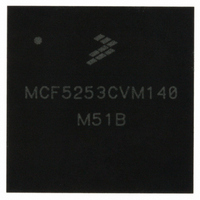MCF5253CVM140 Freescale Semiconductor, MCF5253CVM140 Datasheet - Page 571

MCF5253CVM140
Manufacturer Part Number
MCF5253CVM140
Description
IC MPU 32BIT 140MHZ 225-MAPBGA
Manufacturer
Freescale Semiconductor
Series
MCF525xr
Datasheets
1.MCF5253VM140J.pdf
(34 pages)
2.MCF5253VM140J.pdf
(8 pages)
3.MCF5253VM140J.pdf
(648 pages)
4.MCF5253VM140J.pdf
(2 pages)
Specifications of MCF5253CVM140
Core Processor
Coldfire V2
Core Size
32-Bit
Speed
140MHz
Connectivity
CAN, EBI/EMI, I²C, QSPI, UART/USART, USB OTG
Peripherals
DMA, WDT
Program Memory Type
ROMless
Ram Size
128K x 8
Voltage - Supply (vcc/vdd)
1.08 V ~ 1.32 V
Data Converters
A/D 6x12b
Oscillator Type
External
Operating Temperature
-40°C ~ 85°C
Package / Case
225-MAPBGA
Family Name
MCF5xxx
Device Core
ColdFire V2
Device Core Size
32b
Frequency (max)
140MHz
Instruction Set Architecture
RISC
Supply Voltage 1 (typ)
1.2/3.3V
Operating Supply Voltage (max)
1.32/3.6V
Operating Supply Voltage (min)
1.08/3V
Operating Temp Range
-40C to 85C
Operating Temperature Classification
Industrial
Mounting
Surface Mount
Pin Count
225
Package Type
MA-BGA
Lead Free Status / RoHS Status
Lead free / RoHS Compliant
Number Of I /o
-
Eeprom Size
-
Program Memory Size
-
Lead Free Status / Rohs Status
Compliant
Available stocks
Company
Part Number
Manufacturer
Quantity
Price
Company:
Part Number:
MCF5253CVM140
Manufacturer:
FREESCALE
Quantity:
300
Company:
Part Number:
MCF5253CVM140
Manufacturer:
Freescale Semiconductor
Quantity:
10 000
Part Number:
MCF5253CVM140
Manufacturer:
FREESCALE
Quantity:
20 000
Company:
Part Number:
MCF5253CVM140J
Manufacturer:
Freescale Semiconductor
Quantity:
10 000
- MCF5253VM140J PDF datasheet
- MCF5253VM140J PDF datasheet #2
- MCF5253VM140J PDF datasheet #3
- MCF5253VM140J PDF datasheet #4
- Current page: 571 of 648
- Download datasheet (8Mb)
24.9.12.3.3 Split Transaction Execution State Machine for Isochronous
In this section, all references to micro-frame are in the context of a micro-frame within an H-Frame.
If the Active bit in the Status byte is a zero, the host controller ignores the siTD and continues traversing
the periodic schedule. Otherwise the host controller processes the siTD as specified below. A split
transaction state machine is used to manage the split-transaction protocol sequence. The host controller
uses the fields defined in
Transfers,”
State Machine for Interrupt,”
illustrates the state machine for managing an siTD through an isochronous split transaction. Bold, dotted
circles denote the state of the Active bit in the Status field of a siTD. The Bold, dotted arcs denote the
transitions between these states. Solid circles denote the states of the split transaction state machine and
the solid arcs denote the transitions between these states. Dotted arcs and boxes reference actions that take
place either as a result of a transition or from being in a state.
24.9.12.3.4 Periodic Isochronous—Do-Start-Split
Isochronous split transaction OUTs use only this state. An siTD for a split-transaction isochronous IN is
either initialized to this state, or the siTD transitions to this state from Do Complete Split when a case 2a
(IN) or 2b scheduling boundary isochronous split-transaction completes.
Each time the host controller reaches an active siTD in this state, it checks the siTD[S-mask] against
cMicroFrameBit. If there is a one in the appropriate position, the siTD executes a start-split transaction.
Freescale Semiconductor
Active = 0
Transaction
plus the variable cMicroFrameBit defined in
Complete
IN Split
Transaction
OUT Split
Complete
Figure 24-59. Split Transaction State Machine for Isochronous
Advance Data
Active
Buffer State
Not
Section 24.9.12.3.2, “Tracking Split Transaction Progress for Isochronous
Active = 0
to track the progress of an isochronous split transaction.
Case 2(a,b)
Complete
siTD x–1
MDATA
Active = 1
MCF5253 Reference Manual, Rev. 1
Complete-
Active
Start-
Split
Split
Do
Do
siTD.S-Mask & cMicroFrameBit
Direction .eq. OUT
Not Last
Section 24.9.12.2.5, “Split Transaction Execution
NYET
CheckPreviousBit(C-prog-mask,
.and.
.and.
C-Mask, cMicroFrameBit)
Issue Start-Split
Transaction
Issue Complete-Split
siTD.S-Mask & cMicroFrameBit
Transaction
Direction .eq. IN
.and.
Universal Serial Bus Interface
Figure 24-59
24-109
Related parts for MCF5253CVM140
Image
Part Number
Description
Manufacturer
Datasheet
Request
R
Part Number:
Description:
Mcf5253 Coldfire? Microprocessor Data Sheet
Manufacturer:
Freescale Semiconductor, Inc
Datasheet:
Part Number:
Description:
Manufacturer:
Freescale Semiconductor, Inc
Datasheet:
Part Number:
Description:
Manufacturer:
Freescale Semiconductor, Inc
Datasheet:
Part Number:
Description:
Manufacturer:
Freescale Semiconductor, Inc
Datasheet:
Part Number:
Description:
Manufacturer:
Freescale Semiconductor, Inc
Datasheet:
Part Number:
Description:
Manufacturer:
Freescale Semiconductor, Inc
Datasheet:
Part Number:
Description:
Manufacturer:
Freescale Semiconductor, Inc
Datasheet:
Part Number:
Description:
Manufacturer:
Freescale Semiconductor, Inc
Datasheet:
Part Number:
Description:
Manufacturer:
Freescale Semiconductor, Inc
Datasheet:
Part Number:
Description:
Manufacturer:
Freescale Semiconductor, Inc
Datasheet:
Part Number:
Description:
Manufacturer:
Freescale Semiconductor, Inc
Datasheet:
Part Number:
Description:
Manufacturer:
Freescale Semiconductor, Inc
Datasheet:
Part Number:
Description:
Manufacturer:
Freescale Semiconductor, Inc
Datasheet:
Part Number:
Description:
Manufacturer:
Freescale Semiconductor, Inc
Datasheet:
Part Number:
Description:
Manufacturer:
Freescale Semiconductor, Inc
Datasheet:











